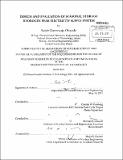Design and evaluation of seasonal storage hydrogen peak electricity supply system
Author(s)
Oloyede, Isaiah Olanrewaju
DownloadFull printable version (37.08Mb)
Alternative title
Design and evaluation of SSHPESS
Other Contributors
Massachusetts Institute of Technology. Dept. of Nuclear Science and Engineering.
Advisor
Charles W. Forsberg.
Terms of use
Metadata
Show full item recordAbstract
The seasonal storage hydrogen peak electricity supply system (SSHPESS) is a gigawatt-year hydrogen storage system which stores excess electricity produced as hydrogen during off-peak periods and consumes the stored hydrogen to produce electricity during peak periods of electricity demand. This thesis investigated and produced high-level system requirements and designs for an SSHPESS. To determine the daily, weekly, and seasonal requirements, analytical and numerical models were developed for all-nuclear, all-wind, and all-solar electricity coupled to storage systems. The electricity demand characteristics were obtained using actual electricity demand data from power grid operators from the North-East and South-West United States (New England, New York, PJM, and California). For an all-nuclear system, it was assumed that electricity was produced at a constant rate. For the wind and solar generating systems, real wind and solar data were obtained using models of wind and solar trough electricity systems. The analyses of the demand characteristics show that for a system containing only base-load plants (all-nuclear electricity systems) with lossless large-scale electricity storage systems, the base-load demand would increase by 50% relative to current electrical infrastructure and 93% of the electricity would be sent directly to customers. About 7% of the annual electricity production would be sent to storage at times of low electricity demand for use at times of high electricity demand. The "7% Nuclear Electricity to Storage Ratio" is applicable to all the power grids considered. Analyses done for inefficient storage systems show that about 11% of the energy produced is sent to storage. The results also show that all-nuclear electricity system requires the least amount of energy storage capacity for seasonal energy storage. As an example, the California grid data is shown below assuming the H2 storage system meets hourly, daily, or weekly energy storage needs.
Description
Thesis (S.M.)--Massachusetts Institute of Technology, Dept. of Nuclear Science and Engineering, 2011. Cataloged from PDF version of thesis. Includes bibliographical references (p. 315-325).
Date issued
2011Department
Massachusetts Institute of Technology. Department of Nuclear Science and EngineeringPublisher
Massachusetts Institute of Technology
Keywords
Nuclear Science and Engineering.